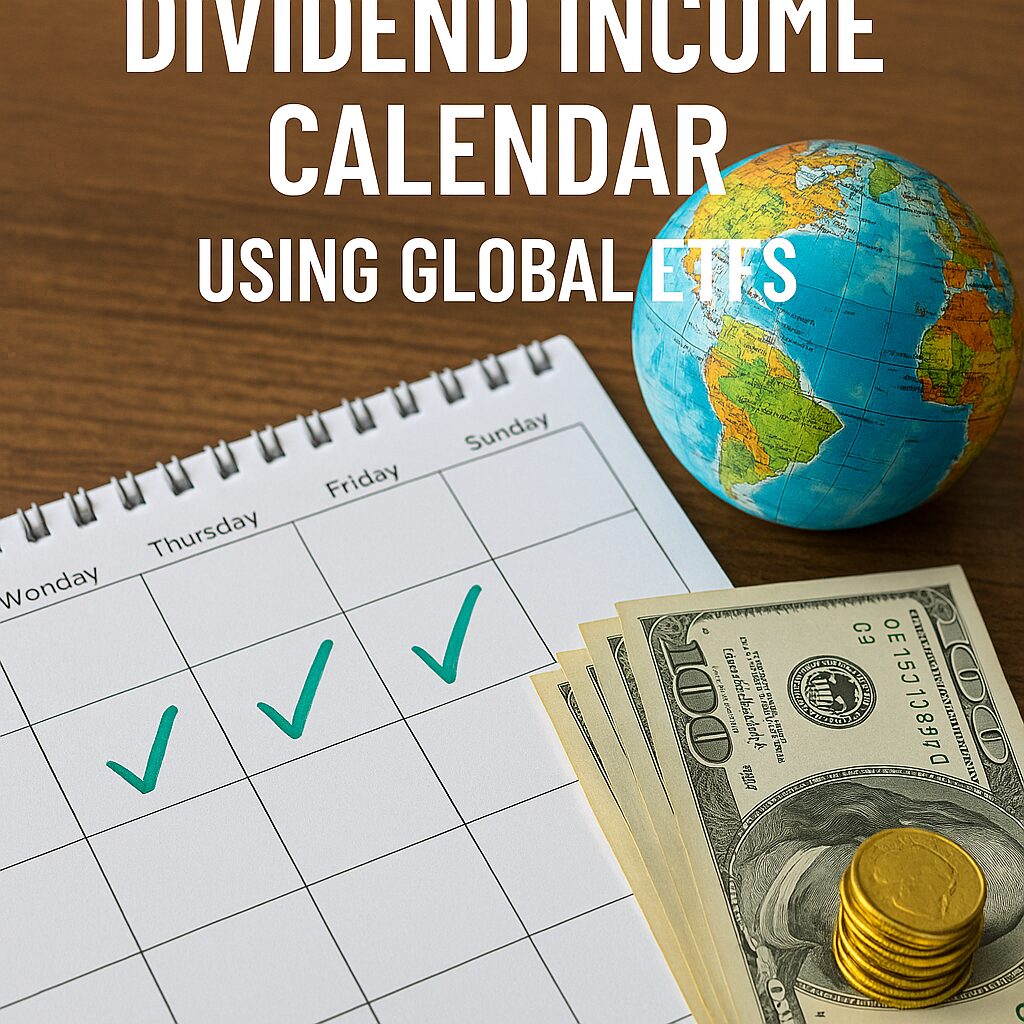Imagine opening your investment app every month and seeing a fresh deposit—without selling a single asset. That’s the power of structuring your dividend portfolio for monthly income. It’s not magic. With the right mix of global ETFs and a payout calendar strategy, you can engineer a consistent cash flow that supports your lifestyle, bills, or reinvestment plan.
This guide will walk you through how to build a monthly dividend income calendar using a combination of U.S. and international ETFs—optimized for yield, payout timing, and diversification.
Why Monthly Dividend Income Matters
While dividends are powerful on their own, they become transformational when they’re timed with real life.
- Bills are monthly. Your income should be too.
- Consistent income means less stress, fewer withdrawals, and greater compounding.
- If you’re living off dividends or planning early retirement, monthly flow creates financial stability.
- Reinvested monthly dividends can also compound faster than quarterly or annual payouts.
Without proper planning, you may receive lumpy income—three ETFs might pay in March, June, and September, but nothing in between. The goal here is to smooth that curve.
Understanding ETF Payout Schedules
Most ETFs distribute dividends on a quarterly basis (every 3 months), but some pay monthly. The key is to:
- Check ETF dividend calendars (available on provider websites)
- Mix payout months to cover each calendar month
- Blend U.S. and international ETFs for added exposure and timing variation
Dividend distributions typically occur in:
- Quarterly: March, June, September, December
- Monthly: End of each month
- Semi-Annually: Less predictable; used in some international ETFs
By selecting ETFs with staggered payout months, you can cover all 12 months of the year.
Best U.S. Monthly Dividend ETFs
These ETFs are designed to provide predictable monthly payouts:
- JEPI (JPMorgan Equity Premium Income ETF)
Yield: ~8–10%
Strategy: Covered call + dividend stocks
Great for high income and stability. - QYLD (Global X Nasdaq-100 Covered Call ETF)
Yield: ~12%
Strategy: Option premium + tech exposure
Great for aggressive income seekers. - SDIV (Global X SuperDividend ETF)
Yield: ~9%
Strategy: Global high-yield equities
Includes U.S. and international stocks. - DIV (Global X SuperDividend U.S. ETF)
Yield: ~7%
Strategy: High-dividend U.S. stocks with low volatility. - SCHD (Schwab U.S. Dividend Equity ETF)
Yield: ~3.5%
Not monthly, but consistent quarterly with DRIP support.
Tip: Focus on monthly payers for steady cash flow, and blend in quarterly ETFs like SCHD for quality.
Best International ETFs for Diversified Payout
International ETFs often pay quarterly, but their payout months can differ from U.S. norms—use that to your advantage.
- VYMI (Vanguard International High Dividend Yield)
Payout: March, June, September, December
Region: Developed + Emerging Markets
Yield: ~4.5% - IDV (iShares International Select Dividend ETF)
Payout: January, April, July, October
Region: UK, Australia, Japan
Yield: ~6.5% - WDIV (SPDR S&P Global Dividend ETF)
Payout: February, May, August, November
Region: Global
Yield: ~5.2% - SCHY (Schwab International Dividend Equity ETF)
Payout: March, June, September, December
Region: Developed ex-US
Yield: ~4.8%
By layering these ETFs, you can fill in the months that U.S. ETFs leave blank, achieving a complete monthly flow.
Monthly Dividend Calendar: Sample Allocation
Here’s an example of a simple portfolio that generates monthly payouts:
| Month | ETF(s) Paying |
|---|---|
| January | IDV |
| February | WDIV |
| March | VYMI, SCHY, SCHD |
| April | IDV |
| May | WDIV |
| June | VYMI, SCHY, SCHD |
| July | IDV |
| August | WDIV |
| September | VYMI, SCHY, SCHD |
| October | IDV |
| November | WDIV |
| December | VYMI, SCHY, SCHD |
To add monthly consistency, include:
- JEPI and QYLD – pay monthly, smooth out cash flow
- DIV or SDIV – additional U.S. or global monthly income
Sample Allocation (for stable monthly income):
- 30% JEPI (monthly)
- 20% VYMI (quarterly)
- 20% IDV (quarterly)
- 15% WDIV (quarterly)
- 15% SCHD (quarterly)
How to Automate Income with DRIP or Sweep Accounts
There are two ways to manage your dividends:
- DRIP (Dividend Reinvestment Plan)
→ Reinvests dividends into more shares of the same ETF
→ Great for compounding and growth - Sweep into cash or high-yield savings
→ If you want to use dividends as income
→ Automate transfer to your checking or savings account
Most brokerages (Fidelity, Schwab, Vanguard) let you toggle between DRIP and cash payout per ETF. You can mix strategies—for example, DRIP on growth ETFs, cash payout on high-yield ETFs.
Tax Considerations for Monthly Payers
- U.S. ETFs in a Roth IRA = tax-free monthly income
- U.S. ETFs in a Brokerage account = 15% qualified dividend rate (if eligible)
- International ETFs = subject to foreign withholding taxes
→ Use foreign tax credit when filing U.S. taxes
→ Or hold them in tax-sheltered accounts
Track your income and taxes with tools like Empower or Sharesight for easier reporting.
Final Thoughts
A monthly dividend income calendar turns your portfolio into a predictable income engine. By combining U.S. monthly payers with global ETFs that stagger distributions, you can create a smooth stream of cash flow throughout the year—ideal for retirees, digital nomads, or anyone pursuing financial independence.
Don’t wait for lumpy quarterly payments. Design your calendar, automate your income, and make dividends work on your schedule.
📌 Coming Up Next
In our next post, we’ll explore how to balance yield and risk in a dividend portfolio—helping you avoid high-yield traps and maintain long-term growth.
→ Learn how to assess dividend sustainability, payout ratios, and total return performance across sectors and regions.
